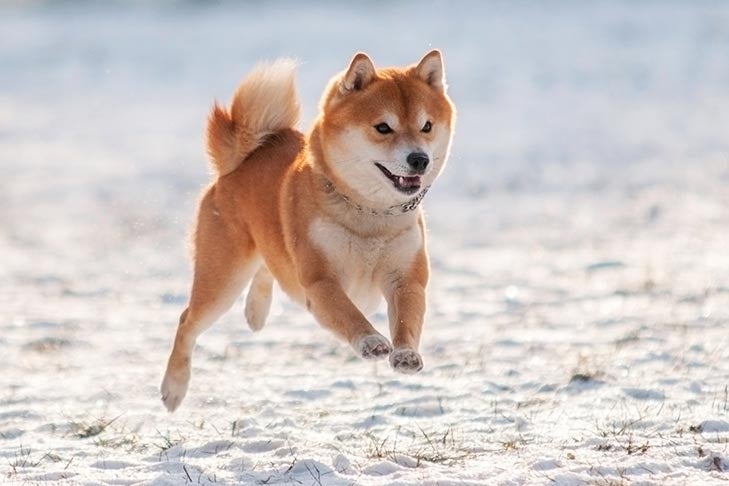Shiba Inu you see smiling today started as hunters and companions to the Samurai in 10th-century Japan. These sturdy, muscular dogs not only developed confidence, a bold personality, and intense loyalty, but also played a crucial role in the lives of these warriors, making them an integral part of Japanese history.
These admirable characteristics, along with the breed’s compact size, alert expression, and signature triangularly set eyes, give the Shiba a foxlike appearance, endearing the Shiba Inu to people for generations.
As the smallest and one of the oldest Japanese dog breeds, the Shiba enjoys celebrated status and is the most popular dog breed in Japan. Shibas are featured in movies and various forms of Japanese popular culture, including internet memes. Their popularity extends beyond Japan, as the Shiba is known as an affectionate companion in the United States.
Naming the Shiba Inu
The name “Shiba Inu” holds historical significance in Japanese culture. It combines “Inu,” or “dog” in Japanese, with “Shiba,” which means “brushwood” or “little brushwood dog.”
The breed’s association with brushwood has a double designation. The breed used to small game like rabbits, foxes, birds, and occasionally wild boar and bear in the underlying mountainous terrain known as brushwood, a woodland of shrubs and piles of small broken branches.
The Shiba’s short, thick, and plush coat, which comes in one of three intense colors: red, red sesame, or black and tan, with a cream, buff, or gray undercoat, resembles autumn brushwood leaves. This camouflage with brushwood helped the dogs blend into their hunting environment.
The breed no longer finds food for warriors, but today’s Shibas maintain their instinct to chase prey, which makes them playful and active companions. This instinct, coupled with their amiable temperament, is a key part of their personality and a permanent reminder of the Shiba’s earliest days.
The Shiba’s Story

Today’s Shibas trace their origin to ancestors who may have accompanied the first immigrants to Japan around 7000 B.C. During excavations, archaeologists discovered evidence of small, 14-1/2 to 19-1/2-inch dogs alongside shell mounds consisting of sacred burial grounds or small hills of debris and discarded shellfish that may have been used in shellfish feasts by the Jomonjim, or Rope-Pattern People.
Another group of people brought their companion dogs when settling in Japan in the third century B.C. These dogs were bred with Jomonjin canine descendants.
During the seventh century, a Japanese court mandated that six native Japanese breeds be vital to Japanese culture. Three varieties of Shibas received identification for their regions of origin. They share similar characteristics but differ in size. The Akita is the largest Japanese spitz-type breed; the Kishu, Hokkaido, Shikoku, and Kai are medium, and the Shiba Inu is the smallest.
Escaping Extinction
Despite their treasured status in Japan, the Shiba Inu has twice faced extinction. The first threat occurred from 1868 to 1912, during the Meiji Era, and worsened from 1912 to 1926 in the Taisho Period.
In 1928, Japanese dog fanciers recognized the need to save the numbers of indigenous dogs and established the Nihon Ken Hozonkai (Japanese Dog Preservation Society). Because of the Shiba Inu’s indigenous nature and cultural significance, it was recognized in 1936 as a National Monument of Japan through the Cultural Properties Act. It is one of nine monument breeds in Japan.
Shiba numbers decreased as Japan ended its isolation and imported Western items, including Western-bred dogs, which were then bred with native Japanese breeds. When scholars and hunters sought to save their bloodline, Japan’s Education Ministry declared the indigenous dogs national monuments.
The second time the breed nearly faced extinction was during and after World War II. Food shortages, bombings, and postwar depression were among the factors impacting Shiba numbers. Following the war, a highly contagious distemper outbreak and a lethal canine viral infection greatly decimated the remaining Shiba population.
The Brushwood Dog in the United States
When an American military family returned from Japan in 1954, they brought their Shiba Inu, the first of its breed in the United States. The breed received official AKC recognition in 1992 and is the AKC’s 136th breed. The National Shiba Club of America is the official AKC parent club for the Shiba Inu.
The Sporty Shiba
A member of the Non-Sporting Group, the Shiba Inu isn’t a sporting breed that enjoys retrieving. They enjoy and can excel in canine sports. Athletic and energetic, these dogs are a great fit for agility and relish the opportunity to navigate jumps, tunnels, and weave poles. This sport gives this intelligent breed plenty of mental and physical stimulation, and they enjoy the challenge of learning new activities.
The Shiba’s prey drive helps them enjoy AKC Fast CAT, in which they chase a mechanically operated lure. Training for obedience and AKC Rally can also prove beneficial to this breed as these activities stress consistency and positive reinforcement, which helps them learn to focus, follow specific commands on cue, and navigate a course.
AKC Barn Hunt especially suits Shibas, who possess a keen sense of smell and a strong urge to locate and indicate a rat hidden in a tube within hay bales. Participating in AKC Trick Dog is a fun activity the family can do with a Shiba at home. The breed is intelligent and can figure out any trick you teach them.
Keeping this breed busy and active not only keeps Shibas stimulated but also builds a lifetime bond.


